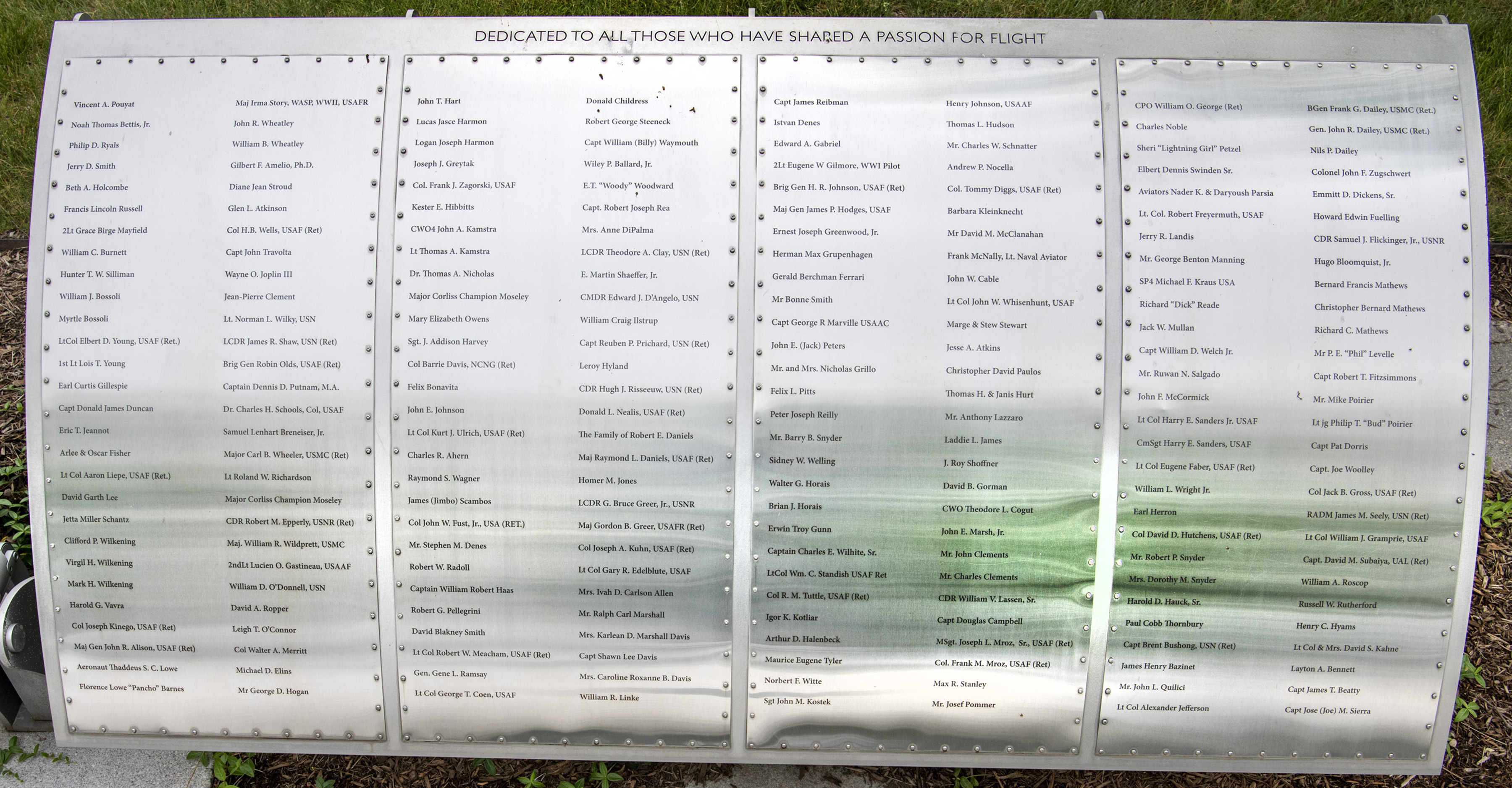Foil: 21 Panel: 3 Column: 1 Line: 7
Wall of Honor Level: Air and Space Sponsor
Honored by:
Ms. Janice Greenwood Fancher
Ernest Joseph Greenwood Jr. was born in Boston Massachusetts in 1913. He became fascinated with flight at an early age and became one of the first to study aeronautical engineering at MIT. He graduated at the height of the depression in 1934 and began hitch hiking around the country and sleeping in fields in search of aircraft design work. After several years of unemployment he was the first in his class to be hired into the aircraft industry. He was the first non-Russian hired to work as an engineer with Igor Sikorsky for $110 a month in Stratford Connecticut.
His first assignment was doing the stress analysis on the wings for the S-42, a large wooden flying boat under Nick Nicholski, who was to become one of his key mentors. After that he did the stress analysis on the S-43, a twin engine amphibian. Each customer would specify changes in the aircraft configuration and Ernest would analyze the change in stress loads. One customer was Howard Hughes, who wanted the fuselage filled with gas tanks, so he could fly around the world.
On July 17, 1936 Ernest married Phyllis Wheeler of Stratford, with whom he had two children, Patricia and Peter. When Sikorsky lost out to Boeing in its bid to build the B-29, Ernest moved on to work for the FAA in Washington, DC, reviewing others plans. But he missed the design work. Shortly after contacting Rex Biesel, who was Chief engineer at Chance Vought, Ernest was back in Stratford working on the F-4U Corsair, which he stayed with throughout the War. The Navy would not let Vought work on any other production aircraft during that time period, Because the Corsair was in such high demand. During the war Ernest also served as an air raid warden, enforcing the blackouts so that the bright lights along the coast would not silhouette our convoys, making them easier targets for German U-boats.
In addition to his design work on modifications for the Corsair during the war, Ernest also worked on the XF5U, the twin engine "flying pancake". After more than 100 test flights in wooden versions, some flown by Charles Lindberg, a full metal version was commissioned by the Navy in 1944. When the war ended, the Navy had the nearly completed metal aircraft destroyed without ever flying it, believing they would never again need to fly the missions it was designed to perform.
After the war Ernest became Chief of Design for Vought's first jet, the F6U-1 Pirate. However, when Chance Vought decided to move from Connecticut to Texas in 1949, Ernest was unable to move because of his wife's illness. Phyllis died in 1951.
After a brief engineering stint at Fairchild in Hagerstown Maryland, Ernest moved to Hamilton Standard where he headed a design group developing jet engine starters and air conditioning systems.
In 1951 Ernest was hired to help revitalize Norden, the famous bombsight maker, which had almost disappeared as a company after the war. The entire company was working out of an old funeral home in Milford, Connecticut. During that same period Ernest was also teaching aircraft design at Princeton on Saturdays. Previously he had co-authored with Joseph R. Silverman, a book on "Stress Analysis for Airplane Draftsmen", published by McGraw and Hill, Incl 1943.
During his first year at Norden, Ernest ("Woody" to his friends) hired a new secretary by the name of Marjorie Ackroyd Baker. She proved to be so capable and brought such joy into his life that two years later they were married. Marjorie's two daughters, Jan and Lynne, brought the number of Greenwood children up to 4.
In 1959 United Aircraft purchased Norden and within a few years Ernest became President and CEO of the Division. During that time period "Ernie's Raiders" were winning 5 out of 6 of their proposals for new work. In the 1960s Norden played a lead role in developing the heads-up display systems for the F-l 11, which could display a map of the local terrain on the cockpit canopy, so that when a pilot broke out of the clouds he would not be disoriented.
Ernest inspired his fellow workers and family with his dedication to the problems and demands of flight. His son, Peter, graduated from the Naval Academy and went on to spend his military career in the Air Force. His grandson, Judson, loving his grandfather's books on flight, went on to graduate from the Air Force Academy and is currently serving as a career fighter pilot.
In 1969 Ernest left the high-pressure world of military contracting to pursue new ventures in modular housing, management recruiting and eventually, to helping run a large technical training institute, Technical Careers Institute, in Hartford Connecticut. Eventually the couple settled in Madison, Connecticut where Ernest volunteers freely and is currently involved in managing their condominium complex.
In addition to watching their four children develop families of their own, Ernest and Marjorie loved to travel in Europe and explore new places.
Wall of Honor profiles are provided by the honoree or the donor who added their name to the Wall of Honor. The Museum cannot validate all facts contained in the profiles.
Foil: 21
